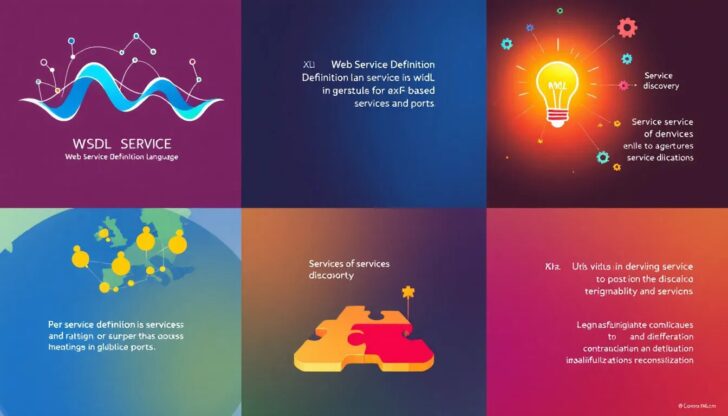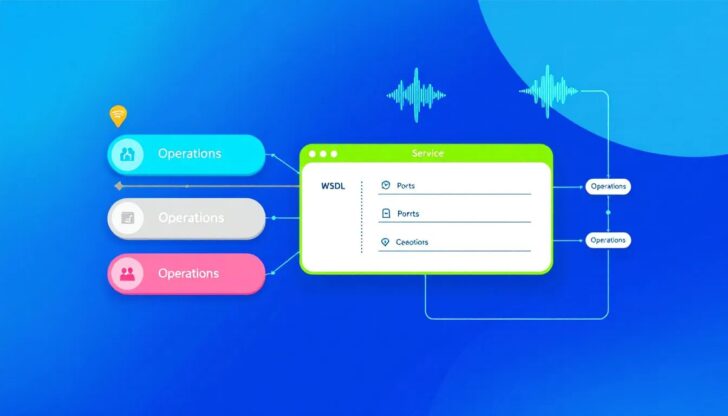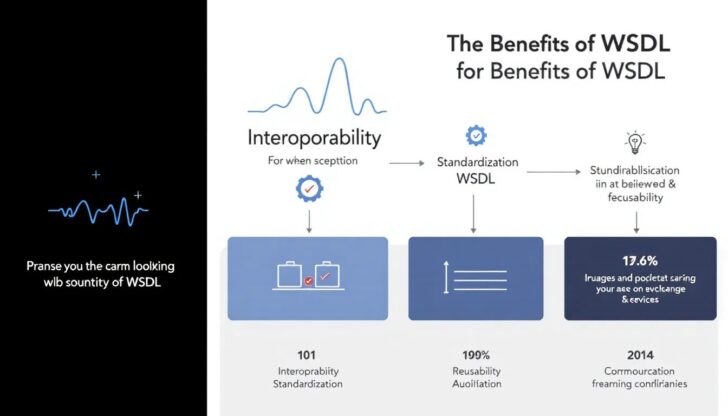Web Service Definition Language (WSDL) is used to describe web services in XML. It specifies what a service does and how to interact with it. This guide will break down WSDL components and show you how to use it.
Table of Contents
Key Takeaways
WSDL is an XML-based language that describes web services, outlining operations, expected parameters, and data structures for seamless inter-system communication.
A WSDL document consists of essential components such as types, messages, portTypes, and bindings, each serving a specific function in defining the web service’s capabilities.
Using WSDL enhances interoperability between different platforms by adhering to standards and supports easier code generation, while tools like SOAPUI assist in validating and testing WSDL files.
What is Web Service Definition Language (WSDL)?

WSDL, or Web Services Description Language, is an XML-based language designed to describe web services and their functionalities, also known as service description language. Think of it as a blueprint that outlines the operations a web service can perform, the parameters it expects, and the data structures it uses. This standardized approach ensures that different systems can communicate seamlessly, regardless of their underlying technologies, including two service description languages.
At its core, WSDL promotes the separation of service definition from its implementation. This means that the details of what a service does are decoupled from how it does it, allowing for greater flexibility and reusability. With its machine-readable format, WSDL allows client applications to precisely grasp the functionality of a web service, ensuring effective communication over standard network protocols.
Moreover, WSDL documents provide location details of web services, making it straightforward to invoke these services. This feature is particularly beneficial in distributed systems, where services may be spread across different servers and networks. Essentially, WSDL serves as a crucial link, allowing diverse systems to interact and share information efficiently.
Key Components of a WSDL Document
A WSDL document is structured into several key components, each playing a vital role in describing the web service. At the heart of every WSDL document is the wsdl definitions element, which serves as a container for all other components. This element establishes the namespaces and overall structure of the document, ensuring clarity and consistency.
WSDL defines four types of operations: one-way, request-response, solicit-response, and notification. Each type caters to different communication needs, from simple message sending to complex two-way interactions. Grasping these operations is key to implementing effective web services.
The structured elements within a WSDL document encompass everything from data types to message formats and operation definitions. These elements work together to provide a comprehensive description of the web service, making it easier for developers to implement and consume these services.
Detailed Look at WSDL Elements
Diving deeper into a WSDL document, you’ll find several main elements, each contributing to the overall service description. These include types, message, portType, binding, and service. Together, these elements create a detailed map of the service’s capabilities and how it can be accessed.
Each element has a specific role, from defining data structures to outlining the operations and binding protocols. Understanding these elements individually is key to mastering WSDL. A closer examination of these components reveals their individual contributions.
Definitions Element
The definitions element is the cornerstone of any WSDL document. It serves as the main container, holding all other elements that define the web service. Within this element, you can find the service’s name and target namespace, which help in uniquely identifying the service and preventing namespace collisions.
This element sets the stage for the entire WSDL document, establishing the context and framework for all subsequent definitions. Organizing the document in this manner ensures WSDL maintains a clear and structured approach to service description.
Data Types Element
The data types element is where complex data structures used by the web service are defined. Often employing XML Schema, this element specifies the various data types that the service can process. These definitions are crucial for structuring messages and ensuring that data is exchanged in a consistent data format specification.
Incorporating XML Schema Definitions (XSD) into the data types element offers a detailed blueprint of the data structures. This level of detail is essential for interoperability, allowing different systems to understand and process the data correctly.
Messages Element
The messages element outlines the data exchanged between the web service and its consumers. Each input message consists of parts, which represent distinct data elements. These parts indicate the data types, ensuring that both the service and the client understand the messages involved and the message format of the exchanged data.
Detailing the input and output messages, this element lays out a clear framework for the communication process. The soap:body element further specifies the details of these messages, ensuring accurate and effective data exchange.
Understanding Port Types and Operations
The port type element is a fundamental part of WSDL, defining the operations that a web service can perform. Unifying multiple message elements, the port type element forms comprehensive operations like one-way or request-response. This categorization allows for flexible communication models between the client and the web service.
Grasping the port type element is essential for understanding the structure and operations of a web service. Let’s delve deeper into this element and its components.
Port Type Element
The port type element outlines the specific operations a web service can perform. Aggregating various operations, this element clearly outlines what the service offers. Each operation within the port type specifies the messages that can be sent and received.
This element is essential for defining the structure of a web service and the interactions it supports. Knowing the port type element helps developers implement and consume web services more effectively.
Operation Element
The operation element in WSDL details the specific message functions provided by the web service. Each operation includes specifications for both input and output messages, outlining the parameters and return types. This level of detail ensures that both the client and the service can communicate effectively.
Specifying message formats and actions for each operation, the operation element is pivotal in the WSDL document. Understanding this element is key to implementing precise and functional web service operations.
Binding WSDL to Protocols

Binding in WSDL links web services to communication protocols, detailing how operations interact with these protocols. The binding element describes the protocols used for communicating each operation defined in the port types. This element is crucial for ensuring that web services can interact over networks using standard protocols.
Understanding the binding element is essential for implementing web services that can communicate effectively across different systems. Let’s explore the specifics of SOAP and HTTP bindings in WSDL.
SOAP Binding
The soap binding element indicates that binding is possible via SOAP and specifies attributes like style and transport. These attributes define how SOAP messages are formatted and transmitted, ensuring consistent communication. The soap:operation element further specifies the operation binding required for SOAP implementation, including the soapAction attribute, which helps route requests effectively.
Understanding SOAP binding enables developers to leverage the SOAP protocol for robust and reliable communication in web services.
HTTP Binding
The http:binding element allows for defining characteristics such as the URI for the service. WSDL supports different HTTP methods like GET and POST for message exchange, providing flexibility in how services are accessed. For more information, visit http www.w3 org.
Knowledge of HTTP binding allows developers to implement web services that use standard HTTP methods, ensuring broad compatibility and ease of use.
Practical Example of a WSDL Document

To bring all these concepts together, let’s look at a practical example of a WSDL document. This example defines a service called HelloService, which includes an operation named sayHello. The operation takes a string parameter and returns a greeting, illustrating the basic structure and functionality of a WSDL document.
In this example, the message SayHelloRequest has a part called firstName, while the message SayHelloResponse includes a part called greeting. The binding section specifies that the service uses SOAP over HTTP for communication.
This example provides a clear and practical illustration of how WSDL defines and provide web services, describing web services.
How to Use WSDL in Your Projects
WSDL files can be utilized by client applications to understand the available operations of a web service. Tools like SOAPUI can simplify working with less-than-ideal WSDL files, assisting developers in navigating and testing them effectively. These tools allow developers to send requests to web services and verify operational accuracy as defined in WSDL files.
WSDL validators assist developers in identifying syntax errors or inconsistencies in WSDL files. Utilizing these tools ensures developers accurately describe and correctly implement their web services.
Benefits of Using WSDL

WSDL provides a high degree of interoperability, allowing systems on different platforms to communicate seamlessly. Adhering to standardized protocols, WSDL avoids the limitations of proprietary solutions and enhances flexibility. Utilizing a Contract-First approach allows developers to leverage the full potential of XML and facilitates easier code generation across different programming languages.
Choosing the Document/Literal style in WSDL enhances XML validation and transformation capabilities. Proper version management ensures clients connect to the correct WSDL file, avoiding compatibility issues. The wsdl 2.0 introduced support for RESTful web services, enhancing the protocol’s flexibility.
Common Challenges and Solutions
One common challenge developers face is version incompatibility between the WSDL file and the application using it. This can lead to issues in consuming the web service, as the client program connecting may not be able to process the service correctly. Connecting clients to the correct WSDL file version is essential for seamless integration.
Another issue is missing or incorrect information within the WSDL file, which can result in errors during service consumption. WSDL validators and thorough testing help identify and rectify issues, ensuring the WSDL file accurately describes the web service.
Complex data types, such as nested structures, can complicate the mapping to programming language data types. Implementing best practices for defining data types and using tools like SOAPUI can reduce complexities, streamlining the development process.
Learn more, Working with WSDL Files | Documentation – SoapUI
Summary
In summary, WSDL is a powerful tool for describing web services, enabling effective communication across different systems and platforms. By understanding its key components and how to use them, developers can create robust and interoperable web services. The practical example provided illustrates how WSDL can be implemented in real-world scenarios, highlighting its importance in modern web development.
The benefits of using WSDL are numerous, from enhanced interoperability to improved performance in distributed systems. Despite the common challenges, the solutions and best practices discussed can help developers overcome these hurdles. Embracing WSDL will not only streamline your development process but also open up new possibilities for efficient and effective web service integration.
Frequently Asked Questions
What is the primary purpose of WSDL?
The primary purpose of WSDL is to describe the operations and functionalities of web services, outlining what the service does and how it should be executed. This facilitates better integration and communication between different services.
What are the key components of a WSDL document?
The key components of a WSDL document are the definitions element, data types element, messages element, port type element, and binding element, each essential for accurately describing the web service. Understanding these components is crucial for effective service integration.
How does the port type element function in WSDL?
The port type element functions by defining a set of operations for a web service, thereby aggregating these operations and detailing the messages utilized in each. This is essential for establishing the service’s capabilities in a WSDL document.
What tools can help in working with WSDL files?
Using tools like SOAPUI can significantly facilitate the process of working with WSDL files by aiding in navigation, testing, and validation, ensuring the accuracy of the web service description. Selecting the right tool enhances efficiency and reduces errors in web service development.
What are the benefits of using WSDL in web services?
Utilizing WSDL in web services ensures high interoperability and adherence to standardized protocols, enhancing the overall reliability and efficiency of service integration. Additionally, it facilitates a Contract-First approach, improves XML validation, and supports RESTful web services in version 2.0.









